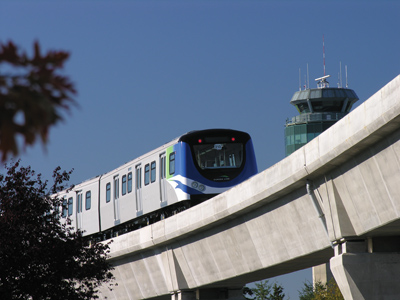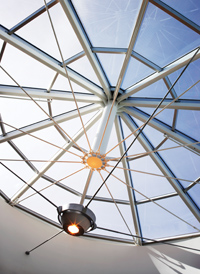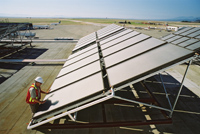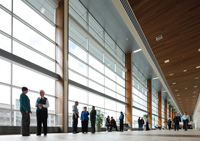
Features
Operations
A BLUEPRINT for green
Airport authorities that have set themselves the task of reducing their environmental footprints (a handy catch-all phrase for a multitude of activities) can collectively offer examples of reducing greenhouse gasses, glycol runoff, energy consumption, food and paper waste, and construction debris . . . the accomplishments in Canada are encouraging.
July 14, 2010 By Carroll McCormick
Airport authorities that have set themselves the task of reducing their environmental footprints (a handy catch-all phrase for a multitude of activities) can collectively offer examples of reducing greenhouse gasses, glycol runoff, energy consumption, food and paper waste, and construction debris . . . the accomplishments in Canada are encouraging.

|
|
| PHOTO: VANCOUVER INTERNATIONAL AIRPORT |
Take construction debris, for example, which can go to the dump, be recycled off site or crushed and reused on site: The Montreal Trudeau International Airport, for one, recovered 58,000 tonnes of concrete and asphalt in 2009 and has recycled 600,000 tonnes of this material since 1998. This work is part of its aéroEco environmental policy which, in part, declares that Aéroports de Montréal (ADM) will “minimize the potential environmental impact of ADM operations and procurement activities by taking action to limit the emission of contaminants, consumption of energy and production of waste.” (Its many projects include replacing cathode ray tubes with flat screen monitors and saving 500 megawatt hours, introducing vehicles that use propane and hydrogen technology and reducing its HVAC usage by 42 per cent.)
The Canadian Airports Council reports that the Pearson International Airport crushed and used 450,000 tons of concrete rubble for road base materials in the preparation of new aprons, and that in 2009 the Vancouver airport recycled 90 per cent of the material from its construction projects.
Sometimes one person’s trash is another’s treasure . . . in the same home! This happened in Winnipeg, where the Winnipeg Airport Authority (WAA) is building a 51,000-square-metre air terminal building. It needed fill, and the Canadian Air Force 17 Wing, which shares the airport with the WAA, had concrete waste from an apron rehabilitation. Simply moving the waste across the airport saved several hundred thousand dollars.
 |
|
| With abundant natural light, the need for artificial light in the daytime is significantly reduced at the Halifax International Airport. PHOTO: HALIFAX INTERNATIONAL AIRPORT AUTHORITY
|
Winnipeg Airport Authority lays claim to being the first airport in North America to register on Canada’s Green Building Council for its new terminal. The WAA is building the terminal to Leadership in Energy and Environmental Design (LEED) standards, which rate the building in five categories: sustainable sites, water efficiency, energy and atmosphere, materials and resources, and indoor environmental quality. In simple strokes, LEED, which is a standard with a worldwide following, is a guide that helps architects and contractors put up buildings that are healthier, consume less energy and reduce their impact on the environment.
Edmonton International Airport’s control and office tower, part of its Expansion 2012 project, is being built to LEED standards. Features chosen or under consideration include a high-reflective roof, fixtures that will reduce potable water use for toilets by 50 per cent, the optimization of energy performance, the use of 15 per cent recycled content and the use of low-emitting materials inside the building.
Late this spring, the Halifax International Airport Authority (HIAA) started moving its air services group (maintenance) and emergency response crew into its newly completed combined services complex. It will certainly achieve LEED certification and may earn a LEED silver rating.
 |
|
| The solar panel rooftop system at the Vancouver International Airport (YVR) supplies hot water to its West Chevron terminal.
|
“The complex is quite an efficient energy design and uses natural gas as a fuel source. It also uses a significant degree of natural light,” says Michael Healy, vice-president, infrastructure and technology, HIAA. Charles Clow, the project manager of the complex, adds, “The outside of the building is designed with a minimum of lights to achieve the light pollution factor credit. We diverted 50 per cent of the waste from the construction into reuse or recycling. We used rubber floors with significant recycled content. We chose low VOC [volatile organic compounds] materials and did a full building flush after the building was completed. Indoor air quality is part of the LEED [process].”
It is difficult to gauge how widespread the effort is to reduce the environmental footprints of Canadian airports. Asked for his opinion, Healy comments, “At a high level, all organizations in the Canadian aviation industry are being more environmentally sensitive.”
Steve Howards is the executive director of the Clean Airports Partnership (CAP) in Arvada, Colo. He looks at the efforts at Canadian airports and says, “Some have done some really cool stuff, but it is much more limited than in the United States. It is not just a shame: If you are not hitting the bar environmentally, you are also not hitting the bar in terms of operational efficiency.”
Clean Airports Partnership is a not-for-profit corporation established in 1998 and “devoted exclusively to improving environmental quality and energy efficiency at airports.” It seems that there is no analogous organization north of the border singularly devoted to promoting energy efficiency at Canada’s airports. There also appears to be no Canadian analogue of the Green Airport Initiative in the U.S., which is a “comprehensive, streamlined approach for helping airports shrink their environmental footprint while creating a blueprint for sustainable development.”
Howards declares, “I would say, without exception, that there is not an airport in Canada that could not save millions of dollars in energy efficiency. Airlines are taking peanuts off of planes and airports are wasting tens of millions of dollars.”
 |
|
| Using the latest development of energy efficient thermal glass, heat producing UV rays are deflected in the daytime while the insulating sandwich glass protects from heat loss at night. PHOTO (top): VANCOUVER INTERNATIONAL AIRPORT; (bottom): HALIFAX INTERNATIONAL AIRPORT AUTHORITY
|
This is not to say that Canadian airports have been idle. The Calgary Airport Authority has reduced energy consumption by 20 per cent in the past six or seven years. As of three years ago it had implemented around 20 main projects, but had never benchmarked them until Blaine Adams, director, maintenance and utilities, spearheaded the certification of the airport through the Calgary branch of the Building Owners and Managers Association (BOMA); it has an environmental certification program for commercial buildings.
“BOMA certification provides a benchmarking tool. It is a standard you create for yourself. It brought to light that we were doing a lot of good things. We should have thanked ourselves years ago. We have to show the public that we care about the environment,” Adams says. (Calgary got its BOMA BESt Level 1 certification in 2007 and is re-certifying this year; Trudeau airport obtained its BOMA BESt Level 2 certification in 2008.)
Any energy use plan at the Calgary International Airport must meet certain criteria: does it make good business sense, does it reduce energy and is it friendly to the environment? Using the benchmark as a reference point, says Adams, allows him to better address the question, “How can we do better and what technologies will take us there? We don’t want to be leading edge or bleeding edge. We want to do what makes sense, because we are still running a business.” As a result of one study, Calgary installed variable frequency drives on its 18 escalators. The project cost $4,500 per unit, with $54,000 in energy savings a year.
Edmonton’s new baggage handling system (BHS) will offer GREENVEYOR conveyors that their manufacturer, Vanderlande Industries, reports are 30 per cent more efficient than conventional conveyors at a test installation at the Heathrow International Airport. Back in Montreal, each section in the 900 metres of belt conveyors in the BHS at Trudeau Airport’s transborder departure sector shuts down independently after a few seconds if it senses there is no baggage on it.
Airport lighting is a tree loaded with low-hanging fruit, ripe to bursting with dazzling energy savings potential: A growing wave of light emitting diode (LED) fixtures is washing over airports. The energy savings range from about 45 per cent to 95 per cent, depending on whether airports do simple fixture-by-fixture replacements of incandescent and halogen with LED, or change the power supply systems in airside circuits to take full advantage of LED’s potential.
The Vancouver International Airport was an early adopter of LED taxiway lighting in North America, and it continues to carry out LED taxiway and airfield lighting projects where appropriate. The Vancouver Airport Authority has saved more than C$4.6 million in electricity costs and more than 14 gigawatt hours of avoided electrical consumption as a result of programs completed between 2001 and 2007. Its new goal as of 2009 is to reduce electrical consumption by two per cent, year over year. One success story is a solar panel system it installed on the roof of the domestic terminal building, which is connected to 80 per cent of the hot water distribution system. It saves $90,000 in annual gas and electricity costs. “It has been so successful that we installed another solar tube power water heating system on the roof of the West Chevron terminal,” says Toni Frisby, the airport authority’s manager of environment.
Vancouver also has a compost program for its retail food and beverage tenants. They can compost all food waste, including meats, paper products, coffee grounds and other organics. Since 2006, the airport has installed 450 new custom-made waste and recycling containers in all terminals and public areas. The airport reports, “These new containers have improved our terminal waste diversion rate (recycling rate) from 24 per cent to 38 per cent. This represents about 460,000 kilograms per year that is no longer going to the landfill.”